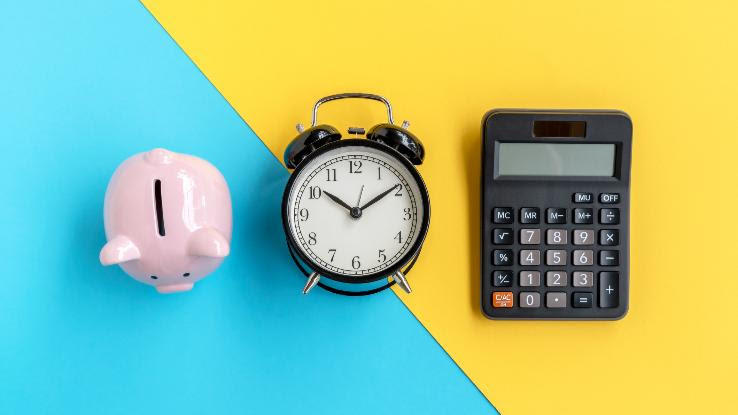
Would you rather get money today — or in five years from now? Most of us would choose today. While this may seem obvious, it’s also backed up by an economic concept called the time value of money (TVM).
More specifically, time value of money illustrates why it’s always more profitable to get money now than accept a promise for the same amount of money in the future. We’ll break down why — and show you how you can use this concept to increase your profits.
What Is Time Value of Money and Why Is It Important?
The time value of money, or TVM for short, is the concept that the sooner you get an amount of money, the more it’s worth. So, what’s the difference between earning $1000 today or the same $1000 in 20 years? For starters, because of inflation, you may not be able to buy as much with $1000 in 20 years as you could today. Additionally, if you intend to invest the money, you’ll lose out on the opportunity to use it to make 20 years’ worth of returns.

When it comes to investing, TVM can help you calculate something called “potential earning capacity.” By factoring in how much of a yield you stand to gain by investing your money now, you’ll be able to see how much you stand to lose if you wait.
Time Value of Money (TVM)
Getting money now — instead of in the future — also increases its utility. In economic terms, this more or less means that the money’s usefulness is increased as is the enjoyment that it has the potential to bring the holder of said money. By being forced to wait to invest, you wind up increasing your opportunity costs — that is, the danger of losing out on potential gains because you chose one option over a better one.

You may have heard the term used in the stock market, where refusing to sell a losing stock ends up racking up opportunity costs. However, by selling sooner and reinvesting your money in a more solid stock or investment, you could have potentially made money instead of watching the losing stock continue to take a nosedive.
The Importance of Time Value of Money
In the case of TVM, the longer you wait to receive money, the opportunity costs you incur due to the inability to invest it. Whatever you’re investing in, especially if the investment guarantees earnings of any sort, time is literally money.

By using a formula that we’ll discuss below, you’ll be able to find out how much it would cost you to wait to receive money in the future. If you’re in a position where you have no choice but to wait to receive payment, you may want to up your price to reflect the future value of the amount rather than its present value.
Moreover, TVM formulas can also help you weigh one investment option against others. Provided that each prospect has a defined interest rate, you can use it to see which will generate the most money in the same amount of time.
How to Calculate Time Value of Money
So, how do you go about calculating the time value of money? Before we jump into the math of it all, let’s go over the factors that often come into play and what they mean. Note that, depending on the situation, you may use all or fewer of the following variables.
In this formula, the symbols signify the following:
- FV = future value, or how much the money will be worth in the future and what we are trying to determine.
- PV = present value, or how much the money in question is worth right now.
- i = interest rate a.k.a. percentage you can earn on your money by investing it.
- n = number (of annual compounding periods) — in other words, how many times per year will the money earn interest once invested? Quarterly, monthly, daily, etc.?
- t = number of years.

Once you’ve got all of your components, it’s time to plug them into one of a variety of handy formulas.
- If your investment comes with an annual interest rate, you can use this formula: FV=PV(1+i)n
- If your interest is compounded more than once a year (daily, monthly, quarterly, etc.), then use this slightly more complex formula: FV = PV x [ 1 + (i / n) ] (n x t)
Did we lose you the second math came into play? You’re not alone. There are plenty of FMV calculators online that will do the math for you when you plug in the values.
Time Value of Money Examples
Sometimes it’s easier to learn from examples, so let’s take our formulas for a test drive, shall we? First, let’s say you have $10,000 that you want to invest in a high-yield saving account with a .60% APY for the next five years. Our variables here would be:
- PV= $10,000
- i= .60%
- n= 5 (years)
So our formula would read: FV=10,000(1+.60)5. A bit of math would reveal that (FV) = $ 10,303.62. This means that we stand a chance to earn $303.62 in 5 years by investing the money today.

Now let’s say that we had instead $25,000 that we wanted to invest in an account with the same .60% yield, but with a quarterly compound rate. Here we’d need to factor in:
- PV = $25,000.00
- i = .60
- n = 5 (years)
- t = 4 (because a quarterly compound rate will apply four times in a year)
So our formula would read: FV = 25,000 x [ 1 + (.60 / 5) ] (5 x 4). Here, the future value of our investment would turn out to be the princely sum of: $25,760.78.
Why Does Money Have a Time Value?
TVM is affected by various factors, some of which depend on what you plan to do with it. For example, if you plan to invest the money in an investment with a guaranteed yield, the sooner you invest it, the more money you stand to make faster. On the other hand, by having to wait to invest your money, you’ll end up incurring opportunity costs.

Even if you don’t plan to invest the money, agreeing to accept payment years down the line comes with its own set of downsides. First of all, there’s no guarantee that the investment will actually come through. The buyer could experience any manner of tragedy in the meantime, ranging from bankruptcy to death.
You should also factor in inflation, which refers to the tendency of prices gradually rising over time. While you might have been able to get a cheeseburger for 15 cents back in 1940, you’d hopefully be hesitant to eat anything that sold for such a low price today. The point is, the longer you have to wait to receive a certain amount of money, the more time prices have to rise and the less you may be able to buy with it when it finally arrives.





